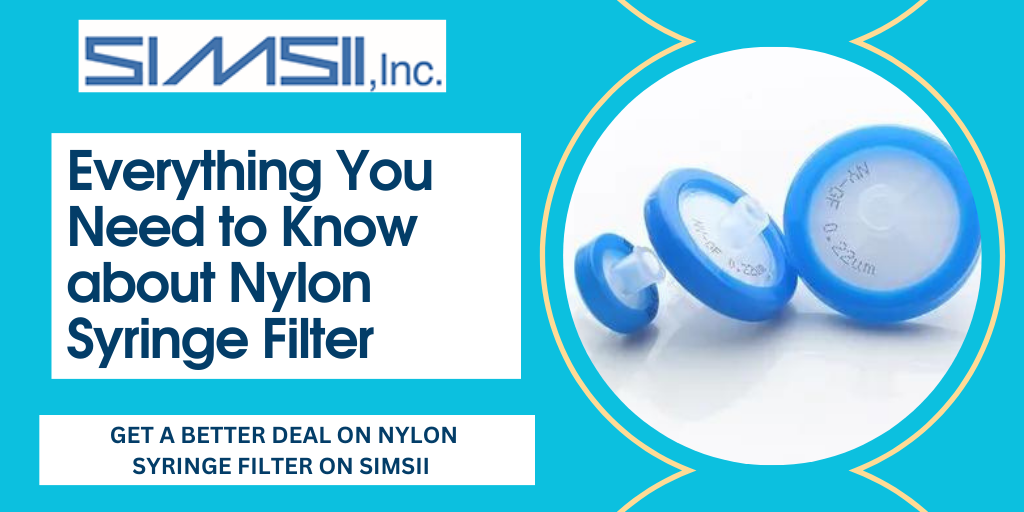When it comes to laboratory filtration, accuracy and dependability are critical. The Nylon Syringe Filter has become an indispensable instrument in the laboratory toolbox as experts and researchers look for effective ways to obtain precise outcomes. In this extensive guide, we will cover all you need to know about nylon syringe filters, including their uses, benefits, and the reasons they are now considered essential in many scientific domains.

A nylon syringe filter: what is it?
A nylon syringe filter is used in laboratories to remove particles and contaminants from liquid samples. It comprises a nylon membrane contained in a syringe, enabling accurate and regulated filtering. The deliberate choice of nylon as the filter material is due to its unique qualities, which meet specific laboratory requirements.
Important attributes and benefits
Chemical Suitability:
Syringe filters made of nylon are renowned for having excellent chemical compatibility. The nylon membrane of these filters is resistant to a broad spectrum of chemicals and solvents, making them appropriate for various uses. One such use is sample preparation for high-performance liquid chromatography (HPLC) and other analytical methods.
Wide Range of Pore Sizes:
Researchers can select the best filter depending on the size of particles they need to remove by selecting from a range of pore diameters offered by nylon syringe filters. Because of its adaptability, nylon syringe filters may be used for various tasks, such as filtering biological samples and sterilizing aqueous solutions.
Elevated Flow Rates:
During the filtration process, significant flow rates are made possible by the structure of the nylon membrane. This is especially helpful when the sample integrity needs to be maintained, but quick and effective filtering is required. The high flow rates enhance the overall effectiveness of laboratory operations.
Poor Binding of Proteins:
Low protein binding is a crucial feature for applications involving protein analysis. Regarding protein-related research, Nylon Syringe Filters show little protein binding, guaranteeing that the desired proteins are kept in the sample and yield precise and trustworthy findings.
Strength and Durability:
Syringe filters made of nylon are renowned for their robustness and longevity. These filters' sturdy design enables them to sustain the pressure used during filtration, guaranteeing dependable and constant performance.
Uses for Nylon Syringe Filters
Nylon syringe filters are versatile and may be used in various scientific applications.
Sample Preparation for HPLC:
Samples are often prepared for HPLC analysis using nylon syringe filters. They are appropriate for assuring sample purity before the models enter the chromatography system because of their low extractable levels and chemical compatibility.
Microbiological Examination:
Eliminating microbial contamination is essential for microbiological analysis. The accuracy of microbiological investigations is improved by efficiently removing bacteria and other microbes using nylon syringe filters with the correct pore diameters.
Deionized Water Filtration:
Aqueous solution filtering works best with nylon syringe filters. The filter's excellent chemical compatibility guarantees its stability and efficacy across aquatic conditions.
Protein Separation:
Protein filtering applications can benefit from nylon syringe filters' low protein binding characteristics. This is especially crucial for investigations where maintaining the integrity of the proteins is vital.
Selecting an Appropriate Nylon Syringe Filter
When choosing a nylon syringe filter, it's essential to consider pore size, chemical compatibility, and the particular needs of the intended use. The success of laboratory processes is enhanced when a filter is carefully selected to ensure that it meets the experiment's objectives.
In Summary
The Nylon Syringe Filter is a dependable and multipurpose instrument in the ever-changing field of laboratory filtration. It is essential to maintaining the precision and effectiveness of laboratory studies because of its wide pore size range, chemical compatibility, and numerous scientific uses. It is an essential tool for achieving scientific excellence in the search for a filtration solution that blends durability and accuracy.


